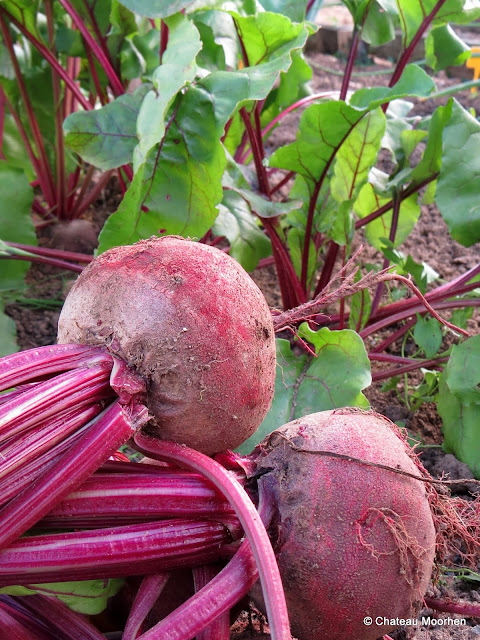Thinking ahead to winter and next year I decided to get in some new layers now, who will hopefully provide us with eggs this winter. The hybrids are bred to lay practically daily for about two years and then they peter out. I've found it a good mix in the past to have breeds mixed with red hybrids as the breeds will usually lay for more years but not during the winter. Now though, I am fed up with prima donnas and neurotic hens and prefer the docile friendly temperament of the red hybrids! I ordered two from a lady with a van who comes around our local agricultural store every week - sad to see they have had their beaks clipped though and I imagine they are raised en masse and sold to battery farms and the like, as well as to the general public.
It's funny how my two really old chickens, Freddy the cockerel and Snowy the Light Sussex, are so blase about new hens they have barely noticed them. However the youngest two are having a great time as they were the newbies who were picked on last time, so they are making a heck of a racket complaining about these two! The newbies seem quite content though and are rather sweet. And one laid an egg on the first day!
 |
| Carly and Gaby, the new red hens. |
The ducks have been so traumatised by Hallie that they won't come up to their shed anymore and won't even come up the garden to get any food! For about 5 days they didn't budge from a small spot by the far end of the pond and I had to take food all the way down to them as they were starving. Now they have returned to the beach area but I'm still having to feed them down there. Neither of the young girls are laying and they are all in various stages of moult anyway. Obviously if you want ducks that lay lots you need to buy the white mixed breed ones like Freckles below, as the pure breeds seem to lay mostly in spring and that's it.
 |
| Ducks - even harder than chickens to photograph. Also Dirk and Doris look practically identical in colouring right now! |
 |
| The juvenile moorhen is growing up fast and enjoying the ducks being fed by the pond! Nothing to do with being self-sufficientish but just for fun. |
Fruit and veg - August and September are busy months harvest wise and the months where we buy not a single vegetable, which is a real delight. I am still buying fruit as I really enjoy summer fruit like peaches and nectarines, and they are only available during the season so I make the most of it! We still have a few strawberries to eat and the autumn raspberries started ripening as soon as the summer ones finished, but I'm not picking tons like I was. I have loads of raspberries in the freezer to turn into jam and to eat during winter. Now the blackberries have started to ripen and they are nice and juicy, unlike last year - this is also the first year for a long time that the wild blackberries are fat and juicy too - many years they are small and hard, which is why I decided to grow the thornless cultivated ones!
 |
| My cultivated thornless blackberries are ripening. Lots of bramble jelly to give to our families when we visit England! |
Unfortunately it's been over two weeks since any rain of note so I am back to watering for about two hours every evening which is tiring and frustrating as it seems like such a waste of time! As soon as I have worked my way around the entire garden with the hosepipe I have to start all over again. We use watering cans for the veggies and all the plants in pots using our stored rain water, but that water is half used already and the warm to hot sunny weather looks set to continue.
 |
| 11th August - leeks newly transplanted and various wildflower meadows in the background. |
 |
| Still struggling to get through last year's pickled beetroot! So made this lot into chocolate beetroot brownies. :-) |
 |
| This was late July and these are supposed to be spring onions.... found seed for the red ones in England, which I had never seen before. They grow big! |
 |
| 'Sweet 100'. This was two weeks ago and now they and the bigger tomatoes are ripening very fast and already I have bags full of tomatoes in the freezer to make sauce from later. |
 |
| Courge Musquée d'Hiver de Provence. One fruit broke off and there are only these two remaining but they are getting bigger and bigger. |
 |
| Dug up more spuds - all these from just six plants of a variety called 'Mandola'. |
 |
| Yet another Pollinator Meadow from last year's saved seed. |
 |
| Yesterday. Just sitting surveying my domain after sowing more rocket and radish seeds. |
Blogging may go a bit quiet as I have family coming to stay next week.


















































